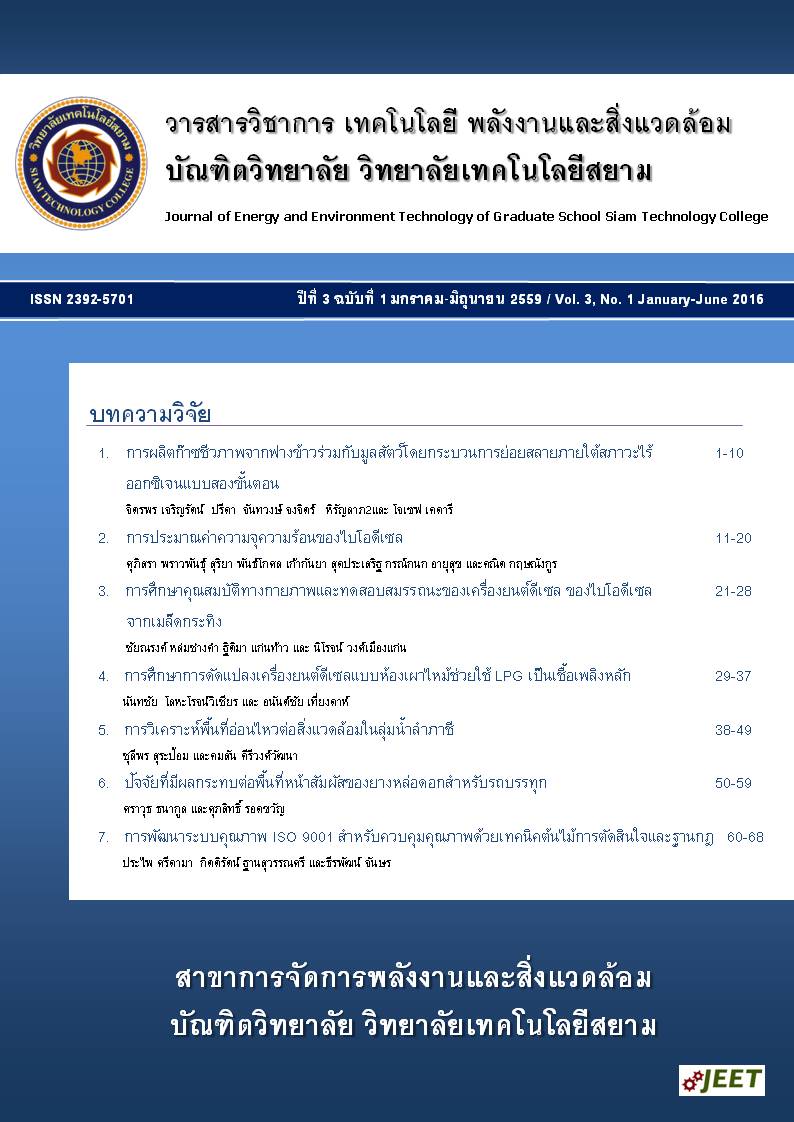Environmentally Sensitive areas Analysis in Lampachi Watershed
Main Article Content
Abstract
The sensitive to environment area is the area where have a sensitive ecosystem. It have to be managed and protected by the government. The objective of the study is to analyze the environmentally sensitive area in Lampachi watershed. The data used to analyze are watershed boundary and slope data derived from digital elevation model. Protected area map such as national park, wildlife sanctuary, watershed class from Department of National parks Wildlife and Plant Conservation (DNP) and soil erosion map which calculated by using RUSLE model. Analyze environmentally sensitive area by overly all the data together in geographic information system (GIS).
The result found that, there is 34.50% of watershed class 1A where located in western and southern of watershed. There is mean of slope 23.22%, and there is 25.53% of slope area more than 35% located in western and southern of watershed. There is less erosion rate area 97.63% of the study area. The most 3 land use are non-evergreen forest, crop, and economic forest which have 50.37%, 21.47% and 9.31% in area respectively. By overlaid all the data found that, there are 43.35% 27.10% and 29.55 of high, Moderate and less environmentally sensitive area respectively and also found that, most of land use on high environmentally sensitive area is natural forest.
Article Details
เนื้อหาและข่อมูลในบทความที่ลงตีพิมพ์ในวารสารวิชาการ เทคโนโลยี พลังงาน และสิ่งแวดล้อม บัณฑิตวิทยาลัย วิทยาลัยเทคโนโลยีสยาม ถือเป็นข้อคิดเห็นและความรับผิดชอบของผู้เขียนบทความโดยตรง ซึ่งกองบรรณาธิการวารสารไม่จำเป็นต้องเห็นด้วย หรือว่าร่วมรับผิดชอบใด ๆ
บทความ ข้อมูล เนื้อหา รูปภาพ ฯลฯ ที่ได้รับการตีพิมพ์ในวารสารวิชาการ เทคโนโลยี พลังงาน และสิ่งแวดล้อม บัณฑิตวิทยาลัย วิทยาลัยเทคโนโลยีสยาม ถือเป็นลิขสิทธิ์ของวารสารวิชาการ เทคโนโลยี พลังงาน และสิ่งแวดล้อม บัณฑิตวิทยาลัย วิทยาลัยเทคโนโลยีสยาม หากบุคคล หรือหน่วยงานใดต้องการนำทั้งหมด หรือส่วนหนึ่งส่วนใดไปเผยแพร่ต่อ หรือเพื่อกระทำการใด ๆ จะต้องได้รับอนุญาต เป็นลายลักษณ์อักษรจากวารสารวิชาการ เทคโนโลยี พลังงาน และสิ่งแวดล้อม บัณฑิตวิทยาลัย วิทยาลัยเทคโนโลยีสยาม เท่านั้น
References
[2]. ชรัตน์ มงคลสวัสดิ์ และสถิพรรณ จันทรัตน์. (2550). การประยุกต์ใช้ระบบสารสนเทศภูมิศาตร์เพื่อจัดทำสารสนเทศพื้นที่อ่อนไหวต่อสิ่งแวดล้อม ภาคตะวันออกเฉียงเหนือ. วารสารสมาคมสำรวจข้อมูลระยะไกลและสารสนเทศภูมิศาสตร์แห่งประเทศไทย. ปีที่8, ฉบับที่2, (พฤษภาคม-สิงหาคม): 28-35.
[3]. A. Gad and I. Lotfy. (2008). Use of Remote Sensing and GIS in mapping the environmental sensitivity areas for desertification of Egyptian territory. The 2nd International Conf. on Water Resources & Arid Environment. eEarth Discussions. Volume 3 (2). pp. 41-85
[4]. อุทยานแห่งชาติและ เขตรักษาพันธุ์สัตว์ป่า. (2552). ความหลากหลายทางชีวภาพ, [ระบบออนไลน์] แหล่งที่มา http://chm-thai.onep.go.th/chm/protected/protected_thai.htm, เข้าถึงเมื่อ 19 พฤษภาคม. 2558
[5]. สำนักความหลากหลายทางชีวภาพ สำนักงานนโยบายและแผนทรัพยากรธรรมชาติและสิ่งแวดล้อม. (2552). พื้นที่คุ้มครองในประเทศไทย. [ระบบออนไลน์], http://chm-thai.onep.go.th/chm/protected/protected_thai.htm, เข้าถึงเมื่อ 11 พฤษภาคม. 2558
[6]. ASTER Global Digital Elevation Model (GDEM). (2015). Features of ASTER GDEM.
URL: http://www.jspacesystems.or.jp/ersdac/GDEM/E/2.html. Accessed March 2 2015.
[7]. กองประสานการจัดการทรัพยากรธรรมชาติและสิ่งแวดล้อม. (2558). การกำหนดชั้นคุณภาพลุ่มน้ำ. [ระบบออนไลน์], http://www.onep.go.th/nrem/index.php/nrem-operation/policy/wsc- project, เข้าถึงเมื่อ 10 มีนาคม 2558.
[8]. สุเพชร จิรขจรกุล. (2552). เรียนรู้ระบบภูมิสารสนเทศด้วยโปรแกรม ArcGIS Desktop 9.3.1. นนทบุรี: เอส.อาร์ พริ้นติ้ง แมสโปรดักส์. หน้าที่ 47.
[9]. หิรัญปกรณ์ ปลื้มมะลัง. (2555). การประเมินการชะล้างพังทลายดินด้วยแบบจ้าลอง RUSLE ร่วมกับภูมิสารสนเทศ. รายงานวิจัยปริญญาบัณฑิต สาขาวิชาภูมิศาสตร์ คณะอักษรศาสตร์ มหาวิทยาลัยศิลปากร. 2556
[10]. Soo Huey The. (2011). SOIL EROSION MODELLING RUSLE AND GIS ON CAMERON HIGHLANDS, MALAYSIA FOR HYDROPOWER DEVELOPMENT. Master Thesis of The School of Renewable Energy Science in affliation with University of Iceland & University of Akureyri. Pp. 15-22
[11]. ไพฑูรย์ คดีธรรมและคณะ. (2542). แผนการใช้ที่ดินลุ่มน้ำสาขาลำภาชี. กรมพัฒนาที่ดิน.


